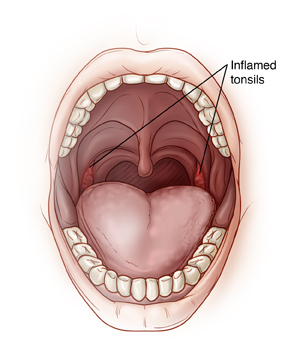Adult Tonsillectomy
Adult Tonsillectomy
The tonsils are 2 small masses of tissue at the back of the throat. They are part of the body’s immune system. This helps the body fight disease. In some people, the tonsils become infected or enlarged. This can cause severe sore throats, snoring, or other problems. Tonsillectomy is surgery to remove the tonsils. Tonsillectomy may be recommended if you have obstruction causing sleep apnea, or recurring, chronic, or severe infections.

Preparing for surgery
Prepare as you have been told. Tell your healthcare provider about all medicine you take. This includes over-the-counter drugs. It also includes herbs and other supplements. You may need to stop taking some or all of them before surgery as directed by your healthcare provider. Also, follow any directions you’re given for not eating or drinking before surgery.
The day of surgery
The surgery takes about 60 minutes. You will likely go home on the same day.
Before the surgery
Here is what to expect before the surgery starts:
-
An IV line is put into a vein in your arm or hand. This line supplies fluids and medicines.
-
To keep you free of pain during the surgery, you’re given general anesthesia. This medicine puts you into a state like deep sleep through the surgery.
During the surgery
Here is what to expect during the surgery:
-
A tube will be placed in your throat to keep your airway open.
-
A special device is used to keep the mouth open.
-
Other tools are used to remove the tonsils or part of the tonsils from the back of the throat. The tissue is taken out through the mouth.
-
The device holding the mouth open and the tube are then removed.
After the surgery
You will be taken to a recovery room. Healthcare staff will make sure you can drink some liquids. They will also make sure your pain is being managed. When you are ready to leave the hospital, you will need to be driven home by an adult family member or friend.
Recovering at home
It will likely take about 2 weeks to heal from the surgery. During your recovery:
-
Expect to have throat pain. You may also feel pain in your ears. This is “referred” pain from the throat, and is normal. Your post-surgery pain may come and go. It may be worse on the 1st or 2nd day after surgery.
-
Talk as little as possible, if it is painful.
-
Take pain medicine as directed. Use liquid pain medicine for pain during the first week, if possible.
- If you have been diagnosed with sleep apnea, talk with your healthcare provider before taking opiods or medicine with codeine.
- For the first 3 days, drink plenty of liquids to keep the area moist. This will also ease pain.
-
Don't drive while you are taking opioid or narcotic pain medicine. Expect to feel sleepy or dizzy while you are taking this medicine.
-
Don't use ibuprofen or aspirin for 14 days after surgery unless your healthcare provider says it’s OK. You may use acetaminophen as directed.
-
. Raise the head of your bed as directed by your healthcare provider.
-
Drink plenty of liquids as you can. Water, noncitrus juices, and frozen juice bars are good choices.
-
Eat cold foods and soft foods, because these are easier to swallow. Try foods such as ice cream, gelatin, scrambled eggs, pasta, and mashed potatoes.
-
Don't eat foods that need a lot of chewing. Also don't have foods that may scratch the throat such as toast or potato chips. Don't have hot, spicy, or acidic foods.
-
Don't do strenuous activity or heavy lifting for 2 weeks after surgery.
-
Be aware that white patches will form in your throat during healing. These are scabs and are not a sign of infection. The patches will come off in 6 to 9 days and may cause a small amount of bleeding. To minimize bleeding, drink plenty of fluids. Gargling with cold water can help.
When to call your healthcare provider
Call your healthcare provider right away if you have any of the following:
-
Chest pain or trouble breathing (call 911)
-
Fever of 100.4°F (38°C) or higher, or as directed by your healthcare provider
-
Bright red bleeding from the mouth or nose
-
Severe pain not relieved by medicine
-
Signs of dehydration (dark urine, urinating less often)
-
Heavy or persistent bleeding in the throat at any time
-
Other signs or symptoms as indicated by your healthcare provider
Follow-up
Schedule a follow-up visit with your healthcare provider, or as advised. During this visit, the healthcare provider will make sure you are healing well. Ask any questions you have about the surgery or your recovery.
Risks and possible complications
-
Infection
-
Bleeding
-
Lung problems
-
Nausea and vomiting
-
Injury to the lips, teeth, or jaw
-
Painful swallowing during recovery
-
Voice changes
-
The need for a second surgery
-
Risks of anesthesia
Updated:
August 22, 2019
Sources:
Hoddeson, E.,Adult tonsillectomy: Current indications and outcomes, Otolaryngology - Head and Neck Surgery (2009); 140(1), Tonsillectomy in adults. UpToDate
Reviewed By:
Ashutosh Kacker MD,Daphne Pierce-Smith RN MSN CCRC,Daphne Pierce-Smith RN MSN CCRC